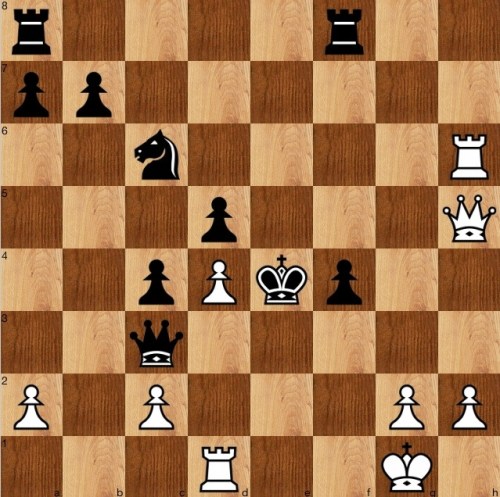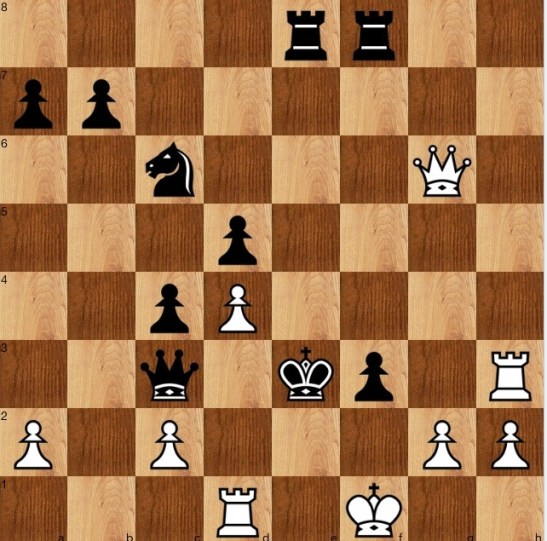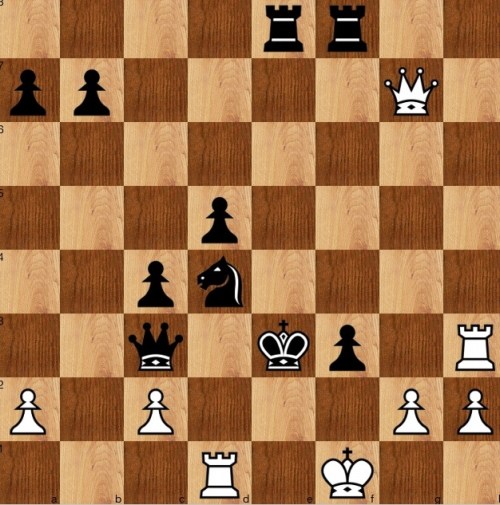Lacking the Master Touch: move of the year
This posting continues my occasional commenting on games in Wolfgang Heidenfeld’s Lacking the Master Touch. The only reason for blogging about certain games or positions is because they interest me. In fact, what better reason is there is blog? I hope my readers also find them of interest.
Game 12 CH Roele v W Heidenfeld, Amsterdam 1954
I wonder if I am the first person in the world to know the truth about one key aspect of this game? I might be, especially if Stockfish is not a person, because, what I have found was computer assisted. Or computer done, to be honest.
What follows clearly was not known to Heidenfeld, despite the fact that he got close to the idea, nor was it found by Max Euwe, who commented on the game in the post mortem.
Also, one aspect of what follows made me truly Laugh Out Loud. There is a truly spectacular mate in one line. My appreciation of Heidenfeld goes up enormously since he found the concept but couldn’t quite deliver it. I didn’t find the concept, Stockfish of course did too.
I hope people enjoy the following as much as I did in finding and understanding it. I will take it in stages, building up to the main points, and also posing a series of questions which I think are worth solving, or at least thinkng about.
The analysis also includes my award for the move of the year.
Black played the best move here, 22…Rae8. What happens if instead 22…Nd4?
As Heidenfeld points out, 22…Nd4? loses to 23 Re6+! Ne6 24 Qd5+ Ke3 25 Qf3mate. We will see Qd5+ in other lines.
White to play and win (level of difficulty: impossible for human life forms): but best to set out the pieces, and give it a good attempt before reading on.
Solution (part 1)
Ignoring clearly irrelevant moves such as 24 a3 or 24 a4 what moves wouldn’t you play here? Heidenfeld played 24 Rh3+ which doesn’t spoil anything yet (there was another chance for him to win next move). Max Euwe suggested in the post mortem 24 Qe6+ but 24…Ne5!! (24…Re6?? 25 Re6+ Ne5 26 Re5 is mate) 25 Qd5 Ke2! 26 de Re5! is a draw by perpetual: 27 Rd2+ Ke1 28 Rd1+, since if 27…Qd2?? 28 Qf3+! Ke1 29 Qf1mate.
The best move is in fact 24 Kf1!!, a move I would frankly never have considered. Its first point is to prevent the black king from moving forward to e2, which was his defence in Euwe’s line.
Question: what else does Kf1 do?
I would never, ever, have guessed the other important feature of Kf1: it frees up the square g1. This answer is ridiculously complex, but all will become clear in a few more moves, though it is worth having a think:
Question: what is the relevance of freeing up g1?
Another feature of 24 Kf1 is that it puts the white king on the same line as the Rf8, so that 24…f3 is sensible, as is then 25 Rh3, reaching the position below.
This is where the win slipped away from white: or rather, he played 24 Rh3+ f3 and could have reached position by playing 25 Kf1!!, but instead played 25 Rf3+ and after 25…Ke2 the game eventually slipped away; 0-1, 42 moves.
Heidenfeld spots 25 Kf1 but says it is met by 25…Nd4! 26 Qh6+ Rf4 27 g3 Re4, when white is in a mating net. He also makes the profound comment:
if 26 Qg5+, so as to preserve the possibility of a fatal check on g1….
showing that Heidenfeld spotted one of the points of Kf1.
In fact, both 26 Qh6+? and 26 Qg5+? were weak. White had an impossible to see win in the above position, which I will repeat below to encourage one more chance to look for it.
White to play: what is the only move that wins?
The answer is 26 Qg7!!
I presume that thanks to Stockfish, I was the first person ever to know this: though of course I might be writing arrant nonsense here. It is a quiet, little, move in a problem like position. Once seen, its point become clearer. Whilst I say it is impossible to see, could someone? Perhaps, and maybe following the Purdy rules it could have been found, and also by spotting the one LPDO: the Qc3. One feature of 26 Qg7 is that it pins the Nd4 because of the LPDO Qc3: the only moves the knight can make are Nb5 or Ne2, protecting the queen, and they lose in similar fashion. e.g. 26…Ne2 27 Qg5+!! Rf4 28 Rf3+! Ke4 29 Qd5mate: we see that one function the Nd4 is performing on that square is to protect the Pd5 from a double attack by queen and Rd1.
A second feature or 26 Qg5 is that it biffs the Nd4: so that 26…Qc2?? is met by 27 Qd4 mate.
A natural response to the biff on the Nd4 is to defend it, with 26…Rf4, met with by 27 gf!, a move I would probably not consider, and when I saw how 27…Qc2?? is met with (Qc2 being ‘possible’ because the Rf4 protects the knight, I laughed out loud. Chess, like live, like music, clearly does have the power to make man happy. The response to 27…Qc2?? is 28 Qgg1+!!, mating.
Could this idea have been foreseen? Not by me, even after Kf1 had vacated the square, let alone when the king was still on g1. But Heidenfeld had clearly seen it, mentioning the g1 square: now that I have seen it, I can rationalise it to Purdy principles: if I were able to follow instructions, to use Purdy’s approach as an algorithm, then I could have been able to see Qg7-g1 as a jump-check which Purdy exorts his readers, time and again, to always consider.
Having dealt with most of black’s defences, the others can be dealt with in similar fashion. For instance, playing a nonsensical move like 26…a6, is met in similar fashion: 27 gf!! setting up the wonderful retreating Qg1, and if that is stopped by 27…Rg8, then 28 Qh6+ and 29 Qg5 are mate; or by 27…Ne2, 28 f4+ double attacks the Qc3. Therefore, 26 Qg7!! is game over.
The whole game is given below.
I think the ending could have been plated better: 32 h6 Rf3 33 Qe6! and I think it is equal: not 33 h7?? because of 33…Rh3+!! and a knight fork follows.
So, in summary:
-
- It is amazing how often it is true when Purdy implores to always look for jump checks and jump biffs. I think part of the failings in my level of play is not being rigorous, not being systematic. Maybe this is just a facet if being human, but it does hurt when I know the rules and don’t follow them.
- I wonder if top GMs are systematic in their approach? Do they, like golfers, have routines, or like astronauts, have checklists and procedures which they go through each and every move.
- Qg7 gets my move of the year award. It is almost a zugzwang inducing move, quiet but deadly.







Trackbacks & Pingbacks